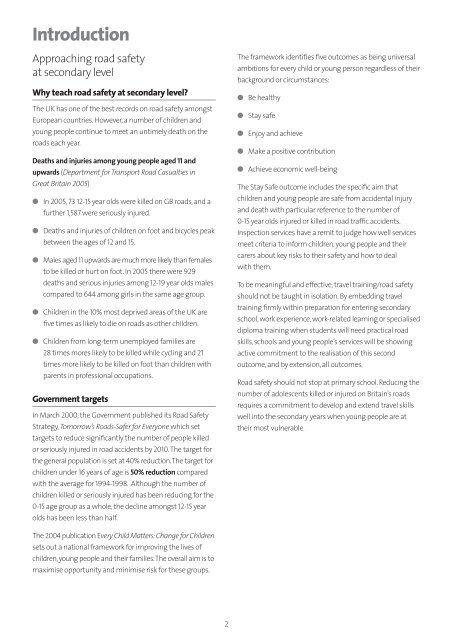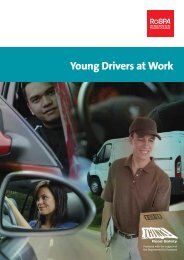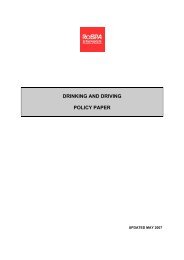Travel training - Key Stages 3 and 4 - RoSPA
Travel training - Key Stages 3 and 4 - RoSPA
Travel training - Key Stages 3 and 4 - RoSPA
Create successful ePaper yourself
Turn your PDF publications into a flip-book with our unique Google optimized e-Paper software.
Introduction<br />
Approaching road safety<br />
at secondary level<br />
Why teach road safety at secondary level?<br />
The UK has one of the best records on road safety amongst<br />
European countries. However, a number of children <strong>and</strong><br />
young people continue to meet an untimely death on the<br />
roads each year.<br />
Deaths <strong>and</strong> injuries among young people aged 11 <strong>and</strong><br />
upwards (Department for Transport Road Casualties in<br />
Great Britain 2005)<br />
l In 2005, 73 12-15 year olds were killed on GB roads, <strong>and</strong> a<br />
further 1,587 were seriously injured.<br />
l Deaths <strong>and</strong> injuries of children on foot <strong>and</strong> bicycles peak<br />
between the ages of 12 <strong>and</strong> 15.<br />
l Males aged 11 upwards are much more likely than females<br />
to be killed or hurt on foot. In 2005 there were 929<br />
deaths <strong>and</strong> serious injuries among 12-19 year olds males<br />
compared to 644 among girls in the same age group.<br />
l Children in the 10% most deprived areas of the UK are<br />
five times as likely to die on roads as other children.<br />
l Children from long-term unemployed families are<br />
28 times mores likely to be killed while cycling <strong>and</strong> 21<br />
times more likely to be killed on foot than children with<br />
parents in professional occupations.<br />
Government targets<br />
In March 2000, the Government published its Road Safety<br />
Strategy, Tomorrow’s Roads-Safer for Everyone which set<br />
targets to reduce significantly the number of people killed<br />
or seriously injured in road accidents by 2010. The target for<br />
the general population is set at 40% reduction. The target for<br />
children under 16 years of age is 50% reduction compared<br />
with the average for 1994-1998. Although the number of<br />
children killed or seriously injured has been reducing for the<br />
0-15 age group as a whole, the decline amongst 12-15 year<br />
olds has been less than half.<br />
The framework identifies five outcomes as being universal<br />
ambitions for every child or young person regardless of their<br />
background or circumstances:<br />
l Be healthy<br />
l Stay safe<br />
l Enjoy <strong>and</strong> achieve<br />
l Make a positive contribution<br />
l Achieve economic well-being<br />
The Stay Safe outcome includes the specific aim that<br />
children <strong>and</strong> young people are safe from accidental injury<br />
<strong>and</strong> death with particular reference to the number of<br />
0-15 year olds injured or killed in road traffic accidents.<br />
Inspection services have a remit to judge how well services<br />
meet criteria to inform children, young people <strong>and</strong> their<br />
carers about key risks to their safety <strong>and</strong> how to deal<br />
with them.<br />
To be meaningful <strong>and</strong> effective, travel <strong>training</strong>/road safety<br />
should not be taught in isolation. By embedding travel<br />
<strong>training</strong> firmly within preparation for entering secondary<br />
school, work experience, work-related learning or specialised<br />
diploma <strong>training</strong> when students will need practical road<br />
skills, schools <strong>and</strong> young people’s services will be showing<br />
active commitment to the realisation of this second<br />
outcome, <strong>and</strong> by extension, all outcomes.<br />
Road safety should not stop at primary school. Reducing the<br />
number of adolescents killed or injured on Britain’s roads<br />
requires a commitment to develop <strong>and</strong> extend travel skills<br />
well into the secondary years when young people are at<br />
their most vulnerable.<br />
The 2004 publication Every Child Matters: Change for Children<br />
sets out a national framework for improving the lives of<br />
children, young people <strong>and</strong> their families. The overall aim is to<br />
maximise opportunity <strong>and</strong> minimise risk for these groups.

















